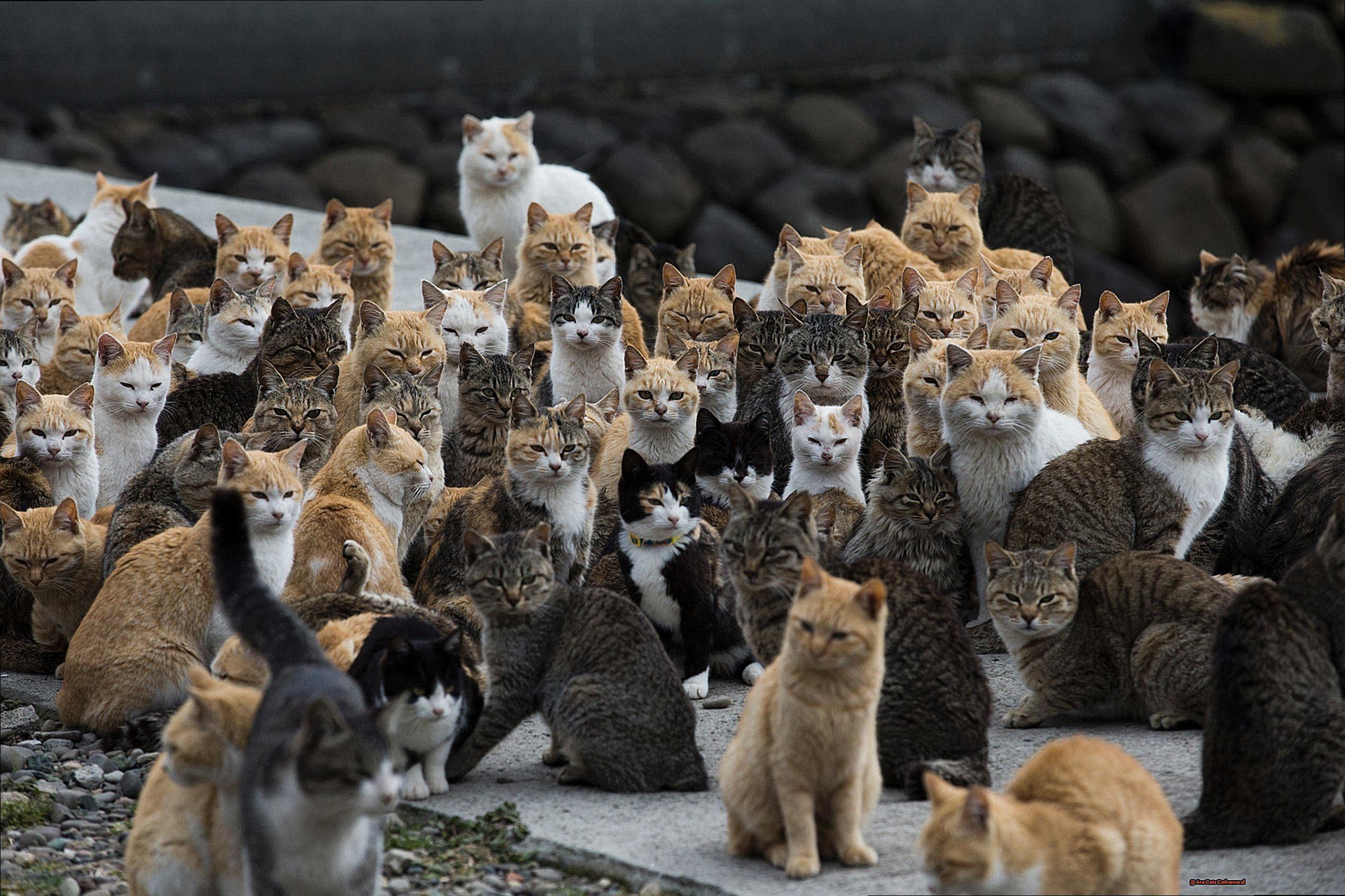Are you ready to explore the enigmatic world of feline behavior? Today, we’re delving into the concept of cathemerality in cats.
But wait, what does that even mean? Well, it’s when an animal is active both during the day and at night, rather than being strictly diurnal or nocturnal.
And as any cat owner knows, our furry friends are notorious for their independent and mysterious ways – including this unique behavior. So snuggle up with your beloved kitty and join us as we uncover the secrets behind their intriguing habits.
Let’s dive in.
Are Cats Cathemeral?
Contents
As a cat owner, have you ever wondered whether your feline friend is truly a nocturnal creature? While it’s commonly believed that cats are only active at night, the answer to this question is more complex than a simple “yes” or “no.” The ongoing debate surrounding whether cats exhibit cathemeral behavior has puzzled experts and pet owners alike. So, let’s delve into this topic and explore the truth behind our furry companions’ activity patterns.
Understanding Cathemeral Behavior
First, let’s define cathemeral behavior. This term comes from the Greek words “kathēmeron,” meaning “all day,” and “hēmera,” meaning “day.” It refers to an animal’s activity pattern where they are active during both day and night, with no distinct preference for either time period. This is different from diurnal animals, which are active during the day, and nocturnal animals, which are active at night.
The Debate: Are Cats Cathemeral?
The debate about cathemeral behavior in cats stems from their domestication and adaptability. While some experts argue that cats are strictly nocturnal animals, others believe they can also exhibit cathemeral behavior. One reason for this debate is that domesticated cats have been living with humans for thousands of years, leading to changes in their natural behavior and activity patterns.
Cats: Crepuscular vs. Cathemeral
In the wild, cats are known to be crepuscular animals, meaning they are most active during dawn and dusk. This behavior allows them to hunt for prey during low-light conditions when their vision is most effective. However, domesticated cats may also adjust their activity patterns to fit their owner’s schedule. They may sleep more during the day when their owners are at work and become more active at night when their owners are home.
Adaptability: A Key Factor
Cats are known for their adaptability, and this also applies to their activity patterns. Studies have shown that cats can adjust their behavior based on the availability of food and resources in their environment. This means that they may switch between nocturnal and diurnal behavior if needed.
The Difference Between Cathemeral, Diurnal, and Nocturnal Patterns
Cats have been domesticated for thousands of years and are known for their independent and aloof nature. However, one aspect of their behavior that has intrigued scientists and cat owners alike is their activity patterns. In this post, we will explore the difference between cathemeral, diurnal, and nocturnal patterns in cats.
What is Cathemeral Behavior?
Cats are crepuscular animals, meaning they are most active during dawn and dusk. However, they are also known to exhibit cathemeral behavior, which refers to animals that have no clear preference for a specific time of day and exhibit activity throughout the day and night. This behavior is commonly seen in cats as they are often observed napping during the day and roaming or hunting at night.
Diurnal vs Nocturnal Behavior
Diurnal animals are most active during the day, while nocturnal animals are most active at night. These behaviors are often associated with specific adaptations and habitats. For example, diurnal animals may have better color vision and be more active during daylight hours to take advantage of food sources and avoid predators. On the other hand, nocturnal animals may have enhanced senses such as night vision and rely on darkness to hunt and avoid predators.
Cathemeral Behavior in Cats

In contrast, cathemeral animals do not have specific adaptations for either day or night activity. Instead, they have a flexible lifestyle that allows them to thrive in various environments and adapt to changes in their surroundings. This can be seen in cats as they are able to adjust their activity levels based on factors such as food availability, temperature, and social interactions.
How to Determine if Your Cat is Cathemeral
So how do you know if your cat is truly cathemeral? One way is to observe their behavior over a period of time. If they consistently show activity throughout the day and night with no clear pattern, they can be considered cathemeral. Another way is to track their daily routines, such as eating, sleeping, and playing, and see if there is a consistent pattern or if it varies day to day.
The Evolution of Cats and Their Activity Patterns
From Wild Hunters to Domesticated Pets
It’s no secret that cats have been domesticated for thousands of years, but their journey from wild hunters to beloved pets is truly fascinating. Our modern-day domestic cats are descendants of wild cats that once roamed the Middle East and Africa. These cats evolved alongside humans, adapting to living in close proximity to us.
As they became domesticated, cats’ behavior changed, including their activity patterns. In the wild, cats are solitary creatures with a primarily nocturnal hunting schedule. But as they began to live with humans, their activity patterns shifted to fit in with our schedules.
Cathemeral Cats: The Best of Both Worlds
So, what exactly is a cathemeral cat? It’s a term used to describe an animal that has multiple periods of activity throughout a 24-hour cycle. Unlike diurnal animals that are active during the day or nocturnal animals that are active at night, cathemeral animals have a flexible schedule.

This evolution of activity patterns in cats can also be attributed to their natural instincts as hunters. In the wild, cats would hunt multiple times a day, taking breaks in between. This behavior has carried over into domesticated cats, leading them to have a similar activity pattern.
Understanding Your Cat’s Daily Habits
According to studies, domesticated cats spend an average of 60% of their day sleeping, 30% being active, and 10% resting or grooming. However, this can vary depending on factors such as age, health, and individual preferences.
It’s important for cat owners to understand their cat’s natural Cathemeral behavior and provide them with an enriched environment that allows for both rest and physical activity throughout the day. This can include providing toys, scratching posts, and safe spaces for your cat to explore and play in.
Factors Influencing a Cat’s Activity Pattern
Some cats are playful and active throughout the day, while others seem to come alive at night. So, what factors contribute to these differences in behavior? As an expert on feline behavior, let me shed some light on the various factors that can influence a cat’s activity pattern.
Breed
One of the most significant factors that can affect a cat’s activity is their breed. Certain breeds, such as Siamese and Abyssinians, are known for their high energy levels and playful personalities. These breeds were originally bred for hunting, so it’s no surprise that they have a more active nature. On the other hand, breeds like Persians and Ragdolls tend to be more laid-back and less active.
Age
Just like humans, cats’ activity levels can change as they age. Kittens are naturally more energetic and curious, often engaging in playful antics throughout the day. However, as they grow older, their activity levels may decrease due to changes in their metabolism and physical abilities. This is why it’s essential to provide senior cats with an enriched environment that encourages them to stay active.
Environment
The environment a cat lives in can also play a significant role in their activity pattern. Indoor cats tend to be less active compared to outdoor cats because they have limited space to roam and play. However, this can be compensated by providing them with enough mental and physical stimulation through toys and playtime with their owners. Outdoor cats have more opportunities for exploration and physical activity, which can also impact their activity pattern.
Other Pets in the Household
If you have multiple pets in your household, their activity patterns can also influence each other. For example, if a cat lives with a dog who is most active during the day, the cat may adjust its own schedule to match the dog’s. This can also be seen in multi-cat households, where one cat’s activity may influence the others.
Individual Personality
Just like humans, cats have their unique personalities that can affect their activity levels. Some cats may naturally be more energetic and curious, while others may be more relaxed and laid-back. This can also depend on how they were raised and socialized by their owners.
How to Identify if Your Cat is Cathemeral
Many people assume that cats are strictly nocturnal animals, but recent studies have shown that they may actually exhibit cathemeral behavior. In this post, we will discuss how to identify if your cat is cathemeral and what this means for their health and behavior.
First, let’s define what cathemeral means. This term refers to an animal’s behavior pattern in which they are active throughout the day and night, rather than having a set diurnal (active during the day) or nocturnal (active at night) schedule. While most people assume that cats are strictly nocturnal, there is evidence that suggests otherwise.
So, how can you tell if your cat is cathemeral? The best way to determine this is by observing their behavior over a period of time. Keep a journal or log of when your cat seems most active and note any patterns you notice. Cats who are cathemeral will typically have spurts of activity throughout the day and night, rather than being consistently active during one specific time. They may also take naps or rest periods in between their bursts of energy.
Some breeds of cats are more likely to exhibit cathemeral behavior, such as Siamese and Bengal cats. This could be due to their genetic makeup, as well as their domestication. Unlike their wild counterparts, domestic cats do not need to hunt for survival and can adapt to their owners’ schedules.
But why do cats exhibit this type of behavior? There are a few factors that can influence a cat’s activity patterns. One is their environment – if there is abundant food available during the day, they may be more active at this time instead of at night. Another factor is stress or boredom – if a cat is kept indoors all day without proper stimulation, they may become more active at night and exhibit destructive behaviors.
It is important for cat owners to understand their pet’s activity patterns as it can affect their behavior and health. If your cat is exhibiting cathemeral behavior, it is perfectly normal and not a cause for concern. As long as they are getting enough total hours of rest, it is not harmful for them to be active at different times throughout the day and night.
In fact, having a cathemeral cat can have its benefits. They are adaptable to different schedules and can provide companionship at any time of day. They may also be less destructive or demanding compared to strictly nocturnal animals.
If you are still unsure whether your cat is cathemeral after observing their behavior, it is always best to consult with a veterinarian or animal behaviorist. They can provide expert insight and help determine if your cat’s behavior is normal or if there may be underlying health or behavioral issues to address.
Health Implications of Cathemeral Behavior in Cats
Cats may nap for hours on end, only to suddenly spring into action at the sound of a treat bag opening. But did you know that this irregular activity pattern is actually part of their natural behavior? Welcome to the world of cathemeral cats.
What is Cathemeral Behavior?
Cathemeral behavior refers to a cat’s natural tendency to be active at various times throughout the day and night, rather than sticking to a strict diurnal (active during the day) or nocturnal (active at night) schedule.
This behavior is seen in many wild cat species such as lions, tigers, and leopards, but it can also be observed in domesticated cats.
The Health Implications of Cathemeral Behavior
While this behavior may seem harmless and even endearing, it can actually have some significant consequences on a cat’s health. One of the main concerns is that it can disrupt their natural sleep pattern, leading to sleep deprivation and other related health issues.
Cats are known to be natural hunters and their cathemeral behavior allows them to adapt to different prey availability and environmental conditions. However, in domesticated cats, this behavior can lead to overeating and obesity if they have access to food at all times. This can increase the risk of health problems such as diabetes, joint issues, and heart disease.
Furthermore, the irregular sleep patterns of cathemeral cats can also affect their mood and behavior. Cats who are not getting enough rest may become irritable, anxious, or even aggressive. This can be a concern for both the cat’s well-being and the safety of their owners.
On the flip side, some experts argue that cathemeral behavior may actually have some positive effects on a cat’s health. It allows them to engage in physical activity throughout the day, which can help maintain their muscle tone and prevent weight gain. It also stimulates their natural instincts and keeps them mentally stimulated.
So what’s the verdict? While cathemeral behavior may have both positive and negative implications for a cat’s health, it is important for cat owners to be aware of their cat’s behavior and take steps to ensure their well-being.
Tips for Managing a Cathemeral Cat’s Activity Levels
Cathemeral cats are those that are active throughout the day and night, with no set schedule for their activity levels. Unlike diurnal animals that are active during the day and nocturnal animals that are active at night, cathemeral cats can be up and about at any time.
As a cat owner, it can be challenging to manage a cathemeral cat’s activity levels. But don’t worry, we’ve got you covered with some helpful tips.
First things first, let’s define what cathemeral means. It refers to an animal’s activity pattern, in which they are active during both day and night. This term is often used in contrast to diurnal (active during the day) and nocturnal (active during the night) patterns.
Now that we understand what cathemeral means let’s dive into some tips for managing your cat’s activity levels.
- Understand your cat’s natural instincts: As descendants of wild cats, domesticated cats still retain some of their natural instincts. This includes their tendency to be cathemeral – hunting and playing at all hours of the day and night. Instead of trying to change this behavior, it’s important to understand and accept it.
- Create a stimulating environment: To manage a cathemeral cat’s activity levels, provide them with a stimulating environment. This can include toys, scratching posts, and perches for climbing and exploring. Interactive toys such as puzzle feeders can also keep them entertained and mentally stimulated.
- Set a routine: While cathemeral cats do not have a set schedule for being active, it’s still helpful to establish a routine for them. This can include playtime during certain times of the day or evening, followed by feeding and then a quiet period for sleeping. This routine helps your cat understand when it’s time to be active and when it’s time to rest.
- Provide adequate exercise: Regular exercise is crucial for managing a cathemeral cat’s activity levels. It not only provides physical stimulation but also helps prevent destructive behavior and weight gain. Activities such as playing with toys, chasing laser pointers, or even taking your cat on walks (if they are comfortable with it) can help burn off excess energy.
- Keep a consistent feeding schedule: Just like humans, cats also have a natural body clock that regulates their metabolism and digestion. To help your cathemeral cat maintain a healthy energy level, feed them at the same time every day. This will also help establish a routine for their activity levels.
Conclusion
In conclusion, after examining the behavior and patterns of cats, it can be said that they are indeed cathemeral creatures.
This means that they have the ability to be active at different times throughout the day and night, depending on their individual needs and preferences. This unique trait allows them to adapt to various environments and thrive in both daytime and nighttime conditions.
So next time you see your feline friend napping during the day or playing at midnight, remember that it’s all part of their natural cathemeral behavior.






